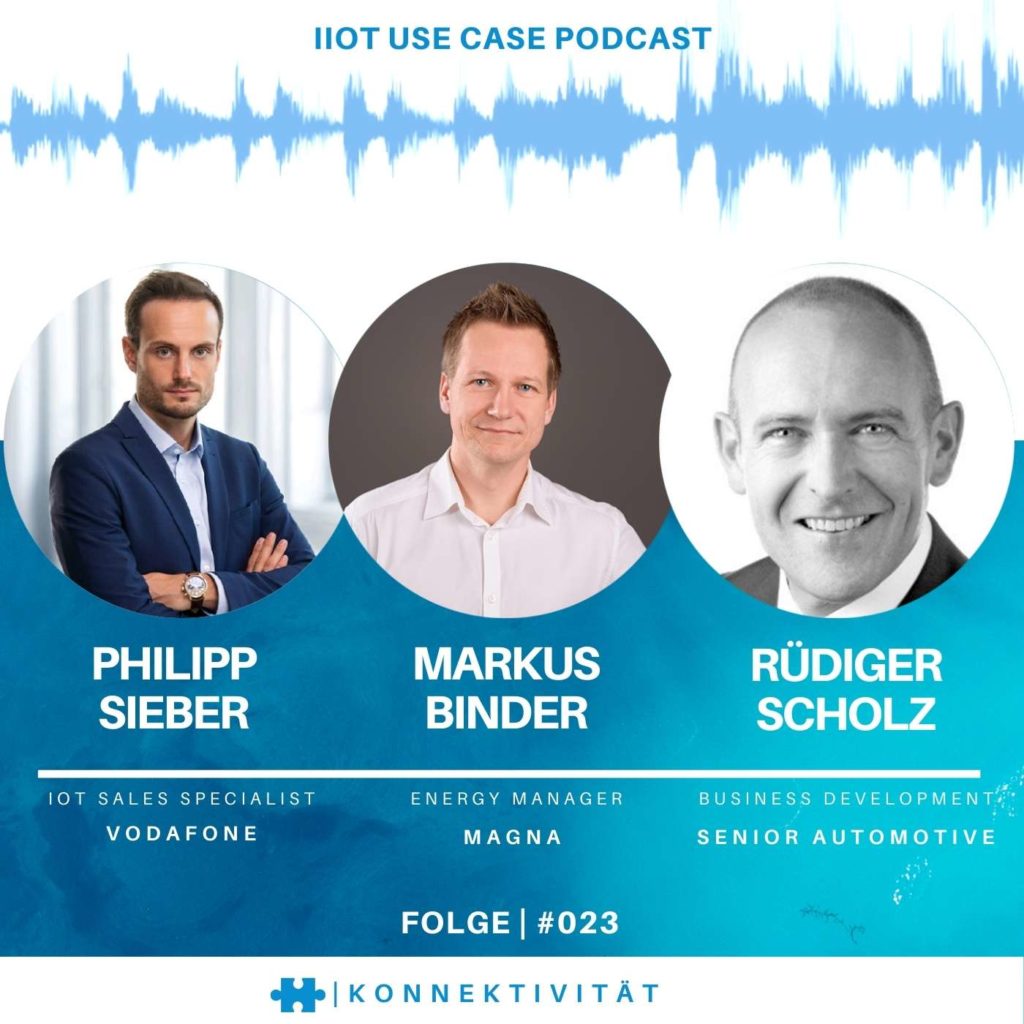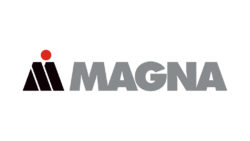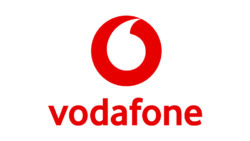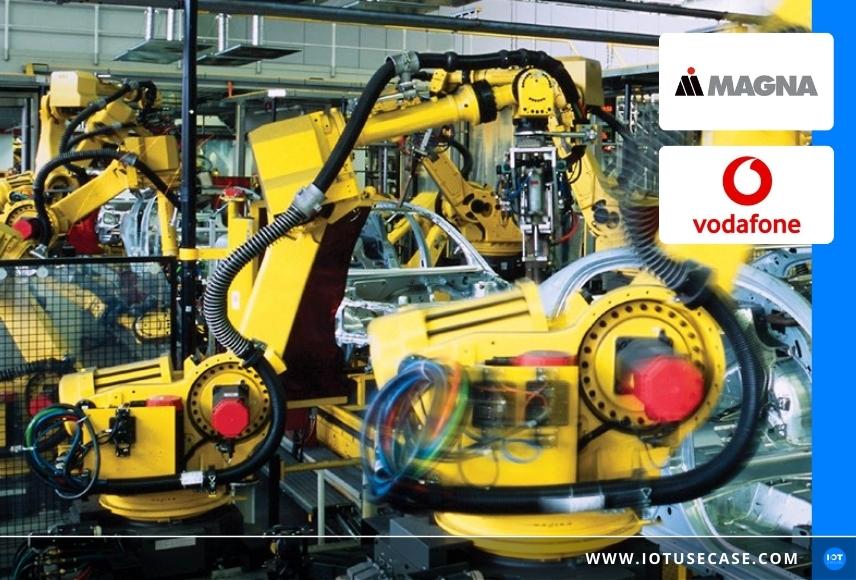In podcast episode 23, Madeleine Mickeleit has three interview partners from Vodafone and Magna as guests. They talk about their successful cooperation in two IoT use cases: More transparency with Energy Data Management (EDM) and private networks and 5G using the example in the e.GO plant.
Podcast Episode Summary
The podcast showcases the added values of the energy management system. The three parties talk about two use cases – preceded by a briefly explained use case to illustrate the topic of private networks and 5G using the example in the plant of e.GO in the automotive production of the electric small car in more detail and to the main use case – more transparency with Energy Data Management (EDM). The project was implemented by Vodafone together with Magna International, the world’s leading automotive supplier. Large savings can be achieved through data from energy meters in the field, intelligent questioning of load profiles, transparency through so-called “heat maps” and data from energy suppliers. At the end, Markus gives us valuable tips from his experiences and Rüdiger an outlook on the topic of 5G.
State-of-the-art automotive manufacturing meets cutting-edge mobile communications technology. Vodafone, Ericsson and e.GO Mobile AG today launch mobile data networking in production. At Plant 1, where e.GO Mobile AG manufactures the e.GO Life small electric car, the network of the future is now transmitting. Vodafone and technology partner Ericsson bring 5G technologies “mobile edge computing” (MEC) and “network slicing” directly to the factory. Small real-time data centers now process the data directly on the production floor. “Network Slicing” creates a self-sufficient network made to measure for e.GO – precisely optimized for the requirements of series production of the small electric car. A total of 36 small mobile radio antennas will guarantee bandwidths in the gigabit range and low latency times of just a few milliseconds in the future in the 8,500m² production hall and the almost equally large logistics hall. Communication between machines is thus even faster, the digital penetration of production processes is higher, and workflows are even more efficient.
Further information on Use Case 1 e.GO
Podcast interview
Hello Markus, Rüdiger and Phillip, welcome to the Industrial IoT Use Case Podcast. Philipp, would you like to introduce yourself briefly?
Philipp: I’m Philipp Sieber, Key Account Manager in the Internet of Things division at Vodafone, and from there I look after the supplier industry with connectivity and end-to-end solutions – focusing on the topics of the digital factory.
Markus, could you also say a few points about yourself and your background, and perhaps give a brief outline of what Magna does exactly?
Markus: My name is Markus Binder and I am the Energy Manager for Europe at Magna, responsible for over 100 production sites in 15 countries. Who is Magna? Magna is a global automotive supplier with currently 346 production sites, over 93 production, development, engineering and sales centers and this in over 27 countries with 152,000 employees. What does Magna offer? Magna offers modular solutions for every system and part of the vehicle as well as complete vehicle assembly and development.
Rüdiger, would you also like to say a few points about yourself and your role at Vodafone?
Rüdiger: My name is Rüdiger Scholz. I work in the same department as Philipp and I’m responsible for Mobile Private Networks or Campus Networks as Business Developing Manager. In this role, I support e.g. Markus as our customer and Philipp as my colleague in the sales department in all matters concerning mobile private networks, 5G, campus networks, etc.
Philipp, how exactly are you moving towards IoT at Vodafone? You are known on the market as a brand for mobile communications. How exactly does that work for you in the IoT sector?
Philipp: Today, Vodafone has over 300 million mobile customers, 27 million fixed-network customers and 22 million TV customers. Vodafone is simply a seasoned player and therefore also a leader in the market. The exciting question now is: What is the IoT sector doing? This is a special area at our company dedicated to the important issues of M-to-M, which stands for Machine-to-Machine Communication. How do we network intelligent devices that then bring the data to the back end accordingly? This is a decisive factor, which we would like to explain in more detail today using the example of a smart factory.
Rüdiger, how exactly do I network the Devices I have in the field? WLAN solutions in a factory are well known. What exactly is the advantage of private networks? And what is the relevance of the topic with regard to the Internet of Things?
Rüdiger: In the past and still in the present, all mobile networks – regardless of the provider – are always intended for everyone. In other words, everyone shares the resource that is available here. This resource is limited, like all other things. As a classic example, you can imagine Munich’s Marienplatz: Lots of tourists, everyone is filming, taking pictures, everyone wants to send them away, and of course that takes time because capacity is limited. With the campus networks, which are now being developed from scratch, dedicated networks are being set up – for example, for a customer like Magna, which is a predestined customer. You build your own mobile network at the customer’s site to create solutions that do not yet exist in this sense and are not possible with a WiFi network, for example. The topic of latency runtimes, how fast can data be transferred? How close am I to reality? Do I have delays? How do I incorporate all the different mobile communication standards that already exist today (e.g. 2G, 3G, 4G or Narrow Band)? And most importantly, how do I make the transition from a mobile network, from a private campus network, to the public network? Because at some point, the asset, the finished product, such as a car, moves. How do I make the transition to the public mobile network here – that is the question.
A quick question in between: For campus networks, are you talking about private networks? It’s sort of a term for this subject, right? Can you go into more detail and perhaps give examples of what exactly the advantages of this solution are?
Rüdiger: These are private networks, correct. The big difference is, of course, security. A mobile network has an essential advantage over all other non-licensed solutions, such as WiFi, WLAN, Bluetooth, etc. In every mobile network there is the SIM card. The SIM card is the device’s elementary key to the network, without which I can’t get in. A WiFi user, for example, always interferes, regardless of whether he or she can get on the network or not. This is not possible on the mobile network. I can’t even get on without the key SIM card. Then, of course, a mobile network is also much, much more protected in terms of data for regulatory reasons. In production, this is essential. On the one hand, I want my production to run optimally, and of course I don’t want my data to vagabond somewhere on the Internet. In other words, you create a solution that is exclusively dedicated to the customer, without the data traveling through the Internet – on the subject of security, that is.
Furthermore, I have to create the possibility to assign the Quality of Service to the applications in a dedicated way, which a WiFi network, for example, cannot do. Let’s take the example of the public network of autonomous driving: a car that drives autonomously needs a higher level of reliability in terms of connectivity than, for example, some teenager who is just uploading a picture on Snapchat or Instagram. It is not critical if it takes a minute. In a self-driving car, this can be fatal.
To understand exactly how something like this works: Do you have an example case from your environment where you have implemented and applied a private network?
Rüdiger: I have an excellent example! A year and a half ago, we equipped a completely new production facility at e.Go, an electric car manufacturer. You have to imagine it like this: This was a hall with well over 10,000 square meters, about the size of two soccer fields. And the challenge we faced was that we needed a non-wireless connectivity layer for all our applications – from the connected worker for augmented reality solutions, for the tablet, connecting the production equipment, from the torque wrench to the welding station, to the paint shop, to a robot that glues in the windows, or safety-related issues like push-to-talk solutions for the worker in hazardous manufacturing environments or video surveillance. At the same time, it is also about the possibility that the finished product, when it leaves the plant, is immediately on Vodafone’s public network and that no further hurdle has to be overcome here.
I would now slowly steer the topic in the direction of Magna. Markus, I’d love to hear more about your use case. What was your challenge in the area of energy management? How did you get started?
Markus: Back then, we still read our energy data from the energy meters. In some cases, there were no automatic logs at all, and if there were, the maximum number of logs might have been entered into an Excel spreadsheet or still had to be read on site by the energy officers. Of course, there was a significant problem of error-proneness. Also, you didn’t have live data or readings every 15 minutes or hourly, you read it once a day or once a week. This means that you had an overview of your energy consumption, but did not know exactly how the energy load or consumption was developing. The challenge was to work together to find a tool that met these requirements. Two important topics: First, live monitoring, so that you can also react immediately if things are going in the wrong direction somewhere. And secondly, that you safeguard the data quality. This is the first cornerstone when talking about energy monitoring and energy management.
And what was Vodafone’s solution to this? Or rather, how did the tool look like in the end?
Markus: The tool from Vodafone has a very simple interface, with so-called widgets, energy diagrams. With a few clicks, you can get all the information you need, such as the load profile in the plant, from a single machine, or even a heat map. You can see how it behaves throughout the day. It’s pretty easy to do and, of course, makes life a lot easier for the energy demand officers at the site. However, if you want, you can also run very deep analyses with the tool. But in 95 percent of the use cases, the simpler interface is enough and that was one of the main criteria why we chose it.
And how did you finally come to the topic of private networks?
Markus: That was not the requirement at that time. But once you have looked at which tool can be used here, you then move pretty quickly in the direction of data transmission and the question of how to get the energy data. Do you really need to wire everything or can you solve this via a nicer way, like wireless technology. This, of course, made it much easier to introduce such a tool and to connect all the meters by not having to wire everything.
How are the individual meters connected to the cloud via the corresponding connectivity layer?
Philipp, I’m looking in your direction again: Can you describe this path from the automation world to the cloud for us?
Philipp: Basically, with this topic of the energy monitoring system, we first do a preliminary analysis with the customer. That means we have what is called a roadmap. This always starts with the introductory call, where we first record the customer’s requirement: What is the hall size? What should be measured? How many meters are there? So first the actual state recording of the whole thing and then we start to define at the meter and sensors. We start in the chain with meters and sensors, then move over to the next block, which is the data logger, and then we go to the next block, which is our IoT global SIM card, which is then configured by mobile connection. The final step would be our platform, which we are developing together with our partner, the Hörburger company, and that is where the data will ultimately be displayed and evaluated. So that’s the way there – from the sensor to the portal. In the beginning, it really starts with a very intensive and coordinated preliminary analysis with the customer.
You’ve just touched a little bit on the role of the on-site energy commissioner. I would now like to know more about the added value of this solution: What exactly do you get out of this energy monitoring system? What problems and challenges did it solve and what exactly is the solution?
Philipp: Let me start with what is actually the decisive and essential advantage of energy monitoring systems. It brings transparency and transparency is the basis to improve. This is the key to success when talking about energy management. I always like to compare the whole thing to a vehicle. When you are on the road with the vehicle, you have all your data in front of you. How fast am I traveling? What is the speed? What about my tank? How much further can I get? So all the information I need I have at a glance. And that’s what you should have in energy monitoring or energy management, of course. If the car’s transformer fails, everything goes dark and you’re flying blind, so to speak – and that’s the same with energy management. In other words, transparency is a key benefit of an energy monitoring system.
And the employee himself, then has this transparency. He doesn’t have to worry about how to get to that transparency beforehand. The monitoring system does this for him and he can then concentrate on an essential part of energy management: the analyses and finding potential.
Are there also advantages there in terms of the current situation with Covid-19 and the lower utilization rates in the plants? Can you look at the data remotely from home, for example?
Philipp: The cloud works great from home. And we had a really great campaign with Vodafone – especially during the Corona period: We made the tool available free of charge for four months at our plants in Germany and Austria. There, all the data from energy suppliers has been automated, all load profiles etc. have been displayed. What was the goal behind this action? Many plants, or almost most plants, were shut down and we still saw that the load factor was still quite high. And that meant that plants were in operation that would not have been absolutely necessary during a non-production time. As part of this campaign, we provided the tool to the plants and they were able to see for the first time how their load profile behaves during non-production time, i.e., during downtime. This analysis was then used to perform so-called energy lockdowns. This means that during the non-production time, we went through the plant and critically examined the equipment to see whether it really had to be in operation or whether it could be switched off. Large savings can be achieved without large investment costs.
There is a very interesting example from practice: One of our locations always had a base load of between 900 and 1,000 KW at the weekend. And through this action, through these site visits with the analysis from the Energy Monitoring System, this base load was reduced to 400 KW. This means 500 to 600 KW less base load. If you extrapolate that with the electricity prices, you come to savings of between 170,000 and 200,000 euros per year – and that’s just by critically scrutinizing and switching off systems.
You said that success often stands or falls with transparency of the processes. Did you know or suspect this potential right at the beginning of the project? Also, am I perhaps only discovering more correlations of data that open new doors through data collection or how did you guys approach the beginning of the project?
Philipp: From experience, we know that on weekends, during the non-production time, plants are always switched on that are not absolutely necessary. That is a potential that is always there, that will never go to zero. By analyzing the load profile of all plants together, we have seen how high the base load is. When the peak load, which is during production time, is somewhere around 40 percent, you know there’s potential there. There is a rule of thumb that you can save 5 to 10 percent with such an energy monitoring system, we have extrapolated that. And that was then also the expectation from this action of all sites.
Keyword: Private networks. The individual devices and energy meters then end up in the cloud. There are certainly different standards involved. Rüdiger, what does such a concept look like with a private network?
Rüdiger: In fact, that’s also something that’s unique to a campus network or a mobile private network. We can integrate all the technologies that are already available today into such a private network or into a campus network. This means that if Magna, for example, were to decide to build a campus network, all devices – electricity meters, flow meters, monitoring stations, everything that is already built today – would be integrated with Narrow Band IoT or perhaps even with classic GSM, UMTS or LTE. As I said in the beginning, each device has something unique and that is the SIM card. That means I know exactly what kind of number it has, what it is allowed to do, what it is not allowed to do? It’s a seamless transition into other technologies, so to speak.
Markus, you said at the beginning that you have various locations around the world that you support. What is a classic project process like? What does the cooperation look like and what kind of issues do I have to consider in order to be able to implement such a project?
Markus: Well, when it comes to cooperation, I can say that the basis is our transparent project structure that we have set up. Each of our sites knows what steps are required to implement an energy monitoring system and it starts with the first on-site meeting. This takes about half a day. In the process, you define all the goals and look at the infrastructure on site. Then comes the big heart of it, before you even introduce anything like that, and that’s the measuring point concept. We worked that out together and it’s the same for every site. This means that every location benefits. You don’t have to start at zero when you begin a project, but start at 30 percent.
Also, we have a common price list across everything – across all the activities, the services and the hardware that is necessary, that is the next big advantage. Again, a site does not have to start from scratch, but can draw on a negotiated list with our purchasing department that has been previously evaluated. And that works brilliantly with Vodafone. We complement each other in that respect, and this project structure is the basis for our good cooperation.
What are the success factors for you? That is, what must occur to make this project successful to you? Do you have an example of what such a solution must bring?
Markus: As mentioned at the beginning, it is first of all the simplicity of the tool, that is quite clear. If I introduce a tool that is so complicated that you don’t want to work with it, that’s bad. So the first expectation is that it’s simple and of course it has to be customizable, extensible and scalable. Customizable in the sense that not every location of our customers is the same, but we want everyone to use the same tool. And here it is very important to respond to the requirements from the plant and then also implement them, without much effort. In this use case, it was the case that we had three different sites. For example, some had their records on a cost center basis, while others had them on a plant or hall basis. And there was the expectation that a tool could do everything, cover all requirements in that respect, and it does.
I can also imagine that this has ultimately also developed historically. You said that, in particular, infrastructure is also relevant. Probably the challenge is to find something modular, but still also establish a standard that you can scale for other plants in the future?
Markus: Exactly, and there again the measuring point concept is an essential factor, that this magic concept is only tailored to the location.
The measuring point concept is arbitrarily complex and I probably have to think about which data I need when and how beforehand. Did you face any specific challenges here?
Yes, and there are two challenges: The first, of course, is when you start with energy monitoring. It makes no sense to run out and install 50, 100 or 150 meters right away and measure every little consumption. You have to think about that well in advance. What do I want to measure? What kind of information should there be? The metering point concept is based on energy consumption, the energy behavior of the equipment and the question of what is really necessary and how I want to build my KPIs. The second challenge is that there are, of course, internal and external requirements.
Philipp, do you have anything to add here?
Philipp: The measuring point concept is based on our flow chart. As Markus has already said, we create a clear target for the whole thing at the beginning: What are the total consumptions? How many cost centers are included? How many measurement points and how many data points are collected? So that you then get a simple clean structure plan. The customer also receives this from us and this is the basis of the measuring point concept that we make together with the customer.
Let’s take another look at the application part, the software. Do you bring in external expertise or do you implement everything in-house? What does your partner management look like?
Philipp: Our partner and ecosystem is a very important pillar when it comes to implementing highly customized requirements. The main objective we are always confronted with is: How does the digital networking of components succeed? And that’s where customers often run into a dilemma, because there’s little capacity. The order books are well filled and then you fall back on an external partner accordingly – and we have one with us. This is the Vodafone company Concentrix, which deals with topics such as embedded services, data science, building scaling backends or even app development. And that’s why this part of relying on partners is an essential point to make it easier for companies to get into the market quickly. We do it the same way by bringing in the Concentrix.
Markus, another question for you. I often ask my interviewees for tips and tricks to share with listeners who may be in a similar situation right now. Do you have any interesting learnings for us that you took away from the practice?
Markus: So the big tip is actually to look at energy consumption during non-production time: Which machines are in operation? Do they have to be in operation? Looking more closely at and critically questioning sayings like “We’ve always done it this way”, and examining everything is really necessary. There really is a lot of potential here in energy management. The basis is, of course, that you have transparency about your energy consumption.
Rüdiger, do you have any additions or even recommendations from your area of expertise – private networks, 5G, etc.?
Rüdiger: As a tip, 5G is already happening today. There are various solutions, also from us at Vodafone, to perform simple tests. I think waiting here until it is completely developed would be a shame and you would lose a lot of time. You can also take the first steps today. As I said, campus networks, mobile, private networks already exist today on the basis of LTE with all the underlying technologies, narrowband, etc. It really is possible to take the first steps today, and the investments involved are also manageable. 5G will be coming in the next few years. We will see highly automated driving here. We will see completely different applications in the public network, but also in the private network. The tip is to really start today with the possibilities that are there, based on LTE and then later with the further developments.
Philipp, do you have anything else to add? What do you think is in store for the future? Do you have any insights from your field?
Philipp: I see the evolution of the SIM card. So that’s my personal opinion and that’s also what we do as a research arm. We know the standard plastic SIM card, the robust SIM card or the eSIM. And a new field is now emerging: the Integrated SIM, the i-SIM. Unlike the conventional SIM card that you insert into the device, this i-SIM is integrated into the processor itself and is part of the chipset. That’s a huge innovation, because you also save money on consumption and you can network everything. We have already established the iSIM at a major customer, namely Bayer, where we were able to optimize the supply chain accordingly. You have to imagine it like this: This is a smart label that is used on the packaging to then check in warehouses to see whether it is too cold there, whether the goods are possibly damaged, and alarms can be triggered as a result. Then you know exactly that this batch has to be taken out of the factory, for example. And that works very well with this i-SIM technology because it is integrated directly onto the label.
This is really an incredibly exciting topic and very future-oriented. Thank you so much for the insights into this project. I’m curious to see what happens next. Many thanks to the round!














